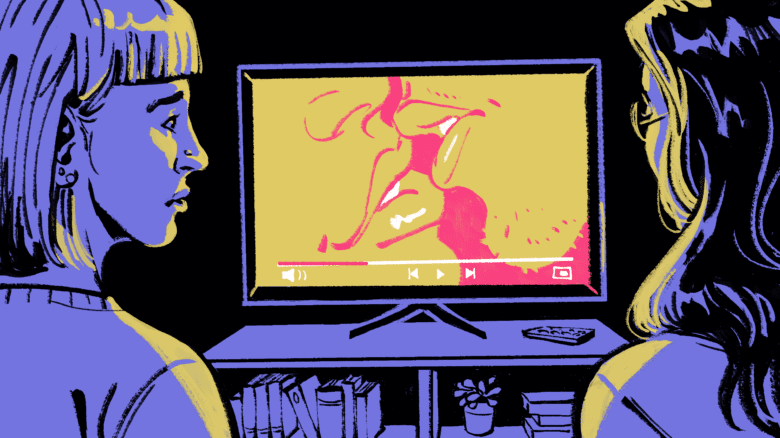Open relationships have exploded in popularity since the first edition of The Ethical Slut by Janet Hardy and Dossie Easton was published in 1997. The book—a counterculture classic often described as the poly bible—redefined slut as “a person of any gender who has the courage to lead life according to the radical proposition that sex is nice and pleasure is good for you.” Twenty years and 200,000 copies later, the third edition was published by Ten Speed Press; sex positivity has gone mainstream.
Despite all of the articles and all of the books, people still have lots of questions. I’m routinely approached by folks who know my husband and I have had an open relationship for a decade. They all ask, in one way or another: How do you do it? How do I get started, safely?
Raj and I opened up a month after we got married in 2010. I fell for a friend of his from grad school. She wanted to date both of us. We spent a whirlwind several months going on dates and having sex in all combinations: me and Raj, me and our girlfriend, our girlfriend and Raj, all three of us. We were living America’s number one fantasy. This sweet relationship came to a close when our girlfriend fell in love with a man she wanted to be monogamous with. Ten years later, we’re still friends.
In the decade since that first open relationship experience, Raj and I have both grown and changed. I’ve always been bisexual—I crushed on boys and girls in first grade—but I discovered in adulthood that I’m kinky, too. And Raj, initially confused about what anyone got out of kink, has found his own relationship with BDSM. I changed my gender four years ago, and the foundation of communication skills we used to navigate our sexual needs helped our marriage weather my transition. Raj took dick pics for me for Grindr. I coached Raj through his first fisting experience. We’ve slept with and fallen in love with plenty of people, together and separately, and we still want to have kids and grow old together.
We’re also lucky to be surrounded by loving partners. Raj’s girlfriend celebrated my first dose of T and my top surgery with me, and came to my shows once I started singing tenor with the San Francisco Gay Men’s Chorus. She is like a sister to me, and I love seeing her and celebrating her family and career milestones. When we get together for tea, we’re warm and relaxed—we know we can be our full selves in each other’s presence.
It was scary for me and for Raj to ask ourselves what we really needed and wanted—both as individuals and as a couple. What if the answers led us to split? But once we started down the road of honesty with ourselves and each other, we couldn’t go back. We were vulnerable with each other and, as a result, we’ve experienced greater intimacy than we thought possible.
I don’t believe that open relationships are intrinsically better or worse than monogamous ones. But I do believe that discovering and articulating your own needs and wants is essential to any healthy relationship.
With that in mind, here’s what I tell couples who ask me how to open up.
1. Don’t open your relationship
So many people rush into this. You have all the time in the world. It may feel urgent, like an opportunity is going to pass you by—but there will be more sparks down the line. Take a deep breath and take your time.
2. Map out your own erotic mind
Regardless of sexual orientation, our brains are our biggest sex organs. Sex in itself doesn’t mean anything—it’s what you make of it. A caress on the cheek can be an expression of tenderness, of dominance, of reward, of respite in between slaps, of empathy during a tough moment. A dick sliding into a lubed up hole can be an expression of physical pleasure, of emotional intimacy with a friend, of conquest, of using a partner as a cum dump, of making sweet, slow love to someone.
The most fundamental question for making open relationships work is this: What are your core erotic desires?
It’s not just what you find hot—it’s why it’s hot to you.
The classic text here is The Erotic Mind by board-certified sex therapist Jack Morin, who studied over a thousand peak erotic experiences to map the contours of what makes us hot—and why. The book is a do-it-yourself guide through your own erotic mind. Read it. Savour it. Relish doing the book’s exercises to map out your own sexuality.
If you only read two chapters, choose Chapter 1 (on peak erotic experiences), and Chapter 5 (on your core erotic theme).
3. Visualize several possible scenes to meet your erotic needs
Now that you have your map, generate a dozen ways to meet each of your key erotic needs. For example: If romance turns you on like nothing else, list 12 ways you could experience romance. Do you want to sweep someone off their feet? Or have someone else sweep you off your feet? What might that look like? Paint the scene in your mind.
If it’s dominance: How might you play with elements of dominance? If you could conjure a perfect dominance session, what would it look like? Who would be there? What would happen? In what order? How would you feel before, during and after? Get specific: sights, sounds, smells, touches, tastes.
These are just two examples. Erotic needs are as varied as people; novelty, prohibition, longing, overcoming obstacles and relaxation are just a few.
Ask yourself: Are you fantasizing about your partner, someone else you know, a stranger?
4. Share what you’ve learned with your partner—and listen to their learnings, too
Choose a time and place where you’re calm, comfortable and not in a rush. Bad: At the end of an awful workday when you’re exhausted from trying to get two very agitated kids to bed. Good: A weekend day on the couch, with the house to yourselves and nothing on the calendar.
Put away your phones and turn off notifications. Be present with each other.
Toss a coin to see who goes first.
When it’s your turn to share, name your key erotic needs. Then tell the hottest stories you can imagine for each need. Talk about what those scenes mean to you—how they make you feel, and why they’re important.
Then have your partner repeat, in their own words, what you’re looking for and why it matters. Tell them if they got it right—and if not, keep talking until they can accurately summarize your needs.
If your partner isn’t quite hearing you, take a deep breath. Tell yourself they love you and they’re doing the best they can. Then ask yourself: Are there metaphors you might use to put this in a way they can better relate to? For example, if your partner is a musician, maybe you could frame your need for variety as a need to explore different genres or instruments.
Next, swap.
When it’s your turn to listen, use your whole body. Watch your partner’s face. Listen to their words and their tone. Feel when they get excited, scared or nervous. Remember that you love this person dearly and they are telling you something incredibly vulnerable. Honour that trust by taking in their story without judgment.
You might be tempted to tell them all your thoughts: things you find hot, things you find gross, things that make you worried you’re going to lose them forever. Take note of those, but don’t share them just yet.
Instead, ask clarifying questions like, “What’s hottest about that for you?” and “Tell me more about that.”
When your partner is finished talking, summarize what they want and why it’s hot for them in your own words. Ask them if you got it right. If not, keep talking until you do get it right.
If you’re not quite hearing your partner, breathe. Remember you love them and commit to doing the best you can to understand. Ask questions to try to put their needs in a frame of reference that makes sense to you.
When you’re all done, check in with each other: What do you need now? Maybe it’s a glass of water or a cuddle or a walk outside or just some alone time.
Congratulations. You just bared your souls. Go do something nice for yourselves.
5. Make a decision
A few days later, return to the conversation. Tell your partner which of their hot scenes feels least scary to you—and why. What about that scene helps you feel secure? Is this something you’d actually be game for trying, in a small way?
Then swap. Once you’ve identified what you’re both up for trying, make a decision: Are you really going to do this? There’s no right answer.
And—surprise!—you might come to the conclusion that what you both want to try the most is something you can do with just the two of you (and maybe some new equipment).
6. If you’re opening up, inhabit the decision for two weeks
When I was paralyzed between two graduate schools, my undergraduate advisor asked me to inhabit the decision: Pick a school, then for two weeks, act as if I were going to that school. Tell my friends, start looking for an apartment and choose my classes. Then—the most important part of it all—listen to my body. Am I queasy? Do I feel tension in my shoulders? Or are all the knots melting away?
Afterward, repeat the exercise for the other school.
One school felt like full colour, vibrant and warm and ready to grow. The other felt dreary, black and white, stuck in the past. The decision was obvious. I love inhabiting decisions—this practice keeps me keep in touch with my body’s intuition, even when my mind is trying to explain away red flags.
If you’ve decided to open your relationship, inhabit the decision for two weeks. Change your relationship status on your favourite dating app. Tell a trusted friend about your new path. Ask your doctor for a sexual health checkup and talk to them about PrEP, a daily pill that prevents HIV. If you or anyone you’re interested in can get pregnant, ask your doctor about birth control, too. Pick your outfit for your first adventure.
Notice what’s going on in your body. Are you beaming with joy when you imagine playing with someone new and coming home to your partner? Or are you spiraling into anxiety, dreading the inevitable decline of a relationship you treasure? What specific thoughts bring up these reactions?
Ask your partner to do the same.
7. Take your first baby step
At the end of two weeks, compare notes. Are you still good to go?
If yes, take your first baby step. Maybe it’s messaging a cutie. Maybe it’s asking a friend who’s been in open relationships for a long time to point you toward events where you can meet people.
Take that first step and notice how you feel. Then take another step, and reflect again. Repeat. You’re on your way.
You’re probably wondering about mechanics: What are the rules? Should we see people together or separately? How do we protect our sexual health? How do we stay safe and smart in a pandemic? How do we deal with jealousy?
Start with the foundational work here. The rules, the choice to play together or separately, the health practices and the strategies for addressing jealousy are all designed to serve your relationship and each of your erotic needs. It’s much easier to construct relationship agreements that work for both of you once you’ve identified what you’re really seeking and why. And there are plenty of guides to help you.
Even if you never open up your relationship, doing the work strengthens your bond. Tuning into and sharing your changing needs and wants—and staying present and attuned as your partner shares their deepest desires—sets the foundation for erotic intimacy for years to come.


 Why you can trust Xtra
Why you can trust Xtra


